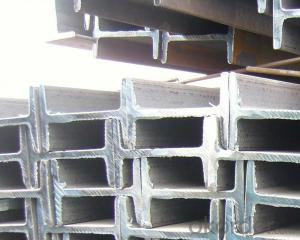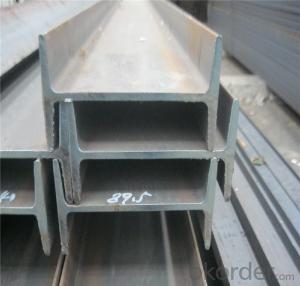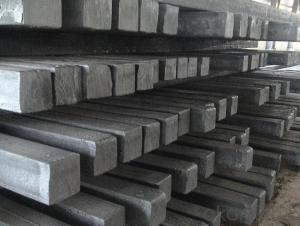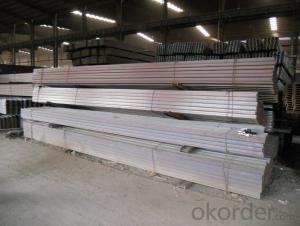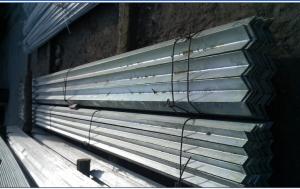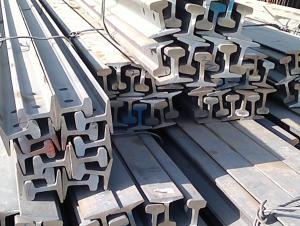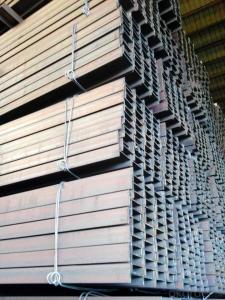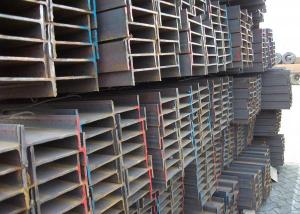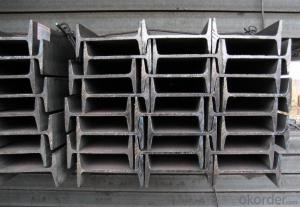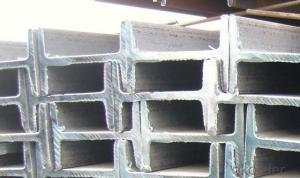High quality I beam GB Q235 or equivalent 80mm-270mm
- Loading Port:
- Tianjin
- Payment Terms:
- TT OR LC
- Min Order Qty:
- 25 m.t.
- Supply Capability:
- 20000 m.t./month
OKorder Service Pledge
OKorder Financial Service
You Might Also Like
IPE Details:
| Minimum Order Quantity: | Unit: | m.t. | Loading Port: | ||
| Supply Ability: | Payment Terms: | Package: | wire rod bundle |
Product Description:
Product Description:
Specifications of IPE Beam
1. Invoicing on theoretical weight or actual weight as customer request
2. Standard: EN10025, GB Standard, ASTM
3. Grade: Q235B, Q345B, SS400, ASTM A36, S235JR, S275JR
4. Length: 5.8M, 6M, 9M, 12M as following table
5. Sizes: 80mm-270mm
Dimensions(mm) | |||||
h | b | s | t | Mass Kg/m | |
IPE80 | 80 | 46 | 3.80 | 5.20 | 6.00 |
IPE100 | 100 | 55 | 4.10 | 5.70 | 8.10 |
IPE120 | 120 | 64 | 4.80 | 6.30 | 10.40 |
IPE140 | 140 | 73 | 4.70 | 6.90 | 12.90 |
IPE160 | 160 | 82 | 5.00 | 7.40 | 15.80 |
IPE180 | 180 | 91 | 5.30 | 8.00 | 18.80 |
IPE200 | 200 | 100 | 5.60 | 8.50 | 22.40 |
IPE220 | 220 | 110 | 5.90 | 9.20 | 26.20 |
IPE240 | 240 | 120 | 6.20 | 9.80 | 30.70 |
IPE270 | 270 | 135 | 6.60 | 10.20 | 36.10 |
Appications of IPE Beam
1. Supporting members, most commonly in the house raising industry to strengthen timber bears under houses. Transmission line towers, etc
2. Prefabricated structure
3. Medium scale bridges
4. It is widely used in various building structures and engineering structures such as roof beams, bridges, transmission towers, hoisting machinery and transport machinery, ships, industrial furnaces, reaction tower, container frame and warehouse etc.
Package & Delivery of IPE Beam
1. Packing: it is nude packed in bundles by steel wire rod
2. Bundle weight: not more than 3.5MT for bulk vessel; less than 3 MT for container load
3. Marks: Color marking: There will be color marking on both end of the bundle for the cargo delivered by bulk vessel. That makes it easily to distinguish at the destination port.
4. Tag mark: there will be tag mark tied up on the bundles. The information usually including supplier logo and name, product name, made in China, shipping marks and other information request by the customer.
If loading by container the marking is not needed, but we will prepare it as customer request.
5. Transportation: the goods are delivered by truck from mill to loading port, the maximum quantity can be loaded is around 40MTs by each truck. If the order quantity cannot reach the full truck loaded, the transportation cost per ton will be little higher than full load.
6. Delivery of IPE Beam: 30 days after getting L/C Original at sight or T/T in advance
Production flow of IPE Beam
Material prepare (billet) —heat up—rough rolling—precision rolling—cooling—packing—storage and transportation
- Q: Can steel I-beams be used in the construction of healthcare facilities?
- Yes, steel I-beams can be used in the construction of healthcare facilities. Steel I-beams are commonly used in construction due to their strength, durability, and ability to support heavy loads. They provide structural stability to the building, making them suitable for healthcare facilities where safety and longevity are crucial.
- Q: How are steel I-beams anchored to foundations?
- Steel I-beams are typically anchored to foundations using anchor bolts. These anchor bolts are embedded into the concrete foundation and provide a secure connection between the foundation and the I-beam. The bolts are usually placed at regular intervals along the length of the I-beam and then tightened to ensure a strong and stable anchoring.
- Q: Can steel I-beams be used for schools and universities?
- Yes, steel I-beams can be used for schools and universities. Steel I-beams are commonly used in the construction industry due to their strength, durability, and versatility. They have excellent load-bearing capacity, making them suitable for supporting the weight of large structures like schools and universities. Additionally, steel I-beams can be easily fabricated and installed, allowing for efficient construction processes. Moreover, steel is a non-combustible material, which is important for ensuring the safety of the building occupants. Overall, steel I-beams are a popular choice for constructing schools and universities due to their structural integrity, cost-effectiveness, and ability to meet the necessary building codes and regulations.
- Q: Build an attic with I-beam. The span is 4 meters. The area is 30 square meters. Does the construction require the qualification of steel structure construction? What are the relevant state regulations?
- 4 meters wide, 8 meters long, 5.7 meters high shops split into 2 layers, with I-beam division, construction needs steel construction qualification? Such a small project, as long as the construction qualification can be. No construction qualification for steel structure is required.
- Q: Demolition of rural cottage bearing wall, take reinforced beam OK?
- Non seismic 6 degrees and above area can use the I-steel beam generation bearing wall bearing, but must be in the wall before the good security measures in the premise, installed and fixed I-beam, and wall.
- Q: What are the different types of steel coatings for I-beams?
- There are several different types of steel coatings that can be applied to I-beams. These coatings serve various purposes, including increasing the durability and longevity of the steel, enhancing its resistance to corrosion, improving its aesthetic appearance, and providing additional protection against fire. One common type of coating is hot-dip galvanizing, which involves immersing the steel beam in a bath of molten zinc. This coating provides a robust and long-lasting protection against corrosion, making it suitable for outdoor or high-moisture environments. Hot-dip galvanizing also creates a barrier that prevents moisture from reaching the steel surface, reducing the risk of rust formation. Another type of coating is epoxy-based paint. This coating is typically applied as a powder or a liquid and is cured through a chemical reaction. Epoxy coatings offer excellent protection against corrosion, chemicals, and abrasion. They are often used in industrial settings or environments with high exposure to harsh conditions. Thermal spray coatings, such as zinc or aluminum coatings, are another option. These coatings are created by melting the coating material and spraying it onto the steel beam. Thermal spray coatings provide a thick layer of protection against corrosion, wear, and heat. They are commonly used in applications where high temperatures or extreme conditions are expected. In addition to these coatings, there are also specialized coatings available for I-beams used in fire-resistant applications. These coatings are designed to delay or prevent the spread of fire by providing a barrier between the steel and the flames. They can be either intumescent coatings, which expand when exposed to heat, or cementitious coatings, which form a protective layer of cement-like material. Ultimately, the choice of steel coating for I-beams depends on the specific requirements of the application, such as the environmental conditions, expected lifespan, and desired level of protection. Consulting with a professional or a steel supplier can help determine the most suitable coating for a particular project.
- Q: What are the design considerations for steel I-beams in high-wind areas?
- In high-wind areas, design considerations for steel I-beams primarily revolve around ensuring sufficient strength and stiffness to resist the imposed wind loads. Factors such as wind speed, direction, building height, and terrain play a crucial role in determining the design requirements. Key considerations include selecting appropriate steel grades, determining the correct size and spacing of I-beams, designing adequate connections, and applying appropriate bracing systems to enhance the overall structural stability against wind forces. Additionally, the design should also account for factors like potential vibrations, fatigue, and corrosion resistance to ensure long-term performance and safety.
- Q: How do you reinforce a steel I-beam?
- One way to reinforce a steel I-beam is by adding steel plates or angles to the flanges of the beam. These additional members are typically bolted or welded to the existing flanges, increasing the overall strength and load-carrying capacity of the beam. Additionally, steel plates can be welded along the web of the I-beam to provide additional stiffness and resistance against bending or buckling.
- Q: Can steel I-beams be used for educational institutions such as schools or universities?
- Yes, steel I-beams can be used for educational institutions such as schools or universities. Steel I-beams are commonly used in construction due to their strength, durability, and ability to support heavy loads. They can be used to construct structural elements like columns, beams, and trusses, providing a solid foundation for educational buildings. Additionally, steel I-beams offer flexibility in design and can be integrated into various architectural styles, making them suitable for educational institutions of different sizes and purposes.
- Q: Are steel I-beams suitable for industrial applications?
- Steel I-beams are an excellent choice for industrial applications. They possess several qualities that make them ideal for use in various industrial settings. Firstly, steel is incredibly strong and durable, capable of withstanding heavy loads and high impact forces. This strength ensures the structural integrity of industrial buildings and equipment, making steel I-beams essential for supporting heavy machinery, bridges, and other industrial structures. Additionally, steel I-beams have excellent resistance to fire, corrosion, and extreme weather conditions. This makes them highly reliable and long-lasting, reducing the need for frequent maintenance and replacement. Steel I-beams can withstand harsh industrial environments, including exposure to chemicals, moisture, and temperature fluctuations, without compromising their strength or stability. Moreover, steel I-beams offer versatility and can be customized to meet specific industrial requirements. They can be fabricated in various sizes, shapes, and lengths, allowing for efficient and precise construction. This versatility enables engineers and architects to design and build industrial structures with maximum efficiency and functionality. Furthermore, steel I-beams are cost-effective in the long run. Although their initial cost may be higher compared to other materials, their durability and low maintenance requirements result in substantial savings over time. Additionally, steel is a sustainable and recyclable material, providing environmental benefits. In conclusion, steel I-beams are highly suitable for industrial applications due to their strength, durability, resistance to fire and corrosion, versatility, and cost-effectiveness. Their ability to support heavy loads and withstand harsh industrial environments makes them an essential component in various industrial settings.
Send your message to us
High quality I beam GB Q235 or equivalent 80mm-270mm
- Loading Port:
- Tianjin
- Payment Terms:
- TT OR LC
- Min Order Qty:
- 25 m.t.
- Supply Capability:
- 20000 m.t./month
OKorder Service Pledge
OKorder Financial Service
Similar products
Hot products
Hot Searches
Related keywords
